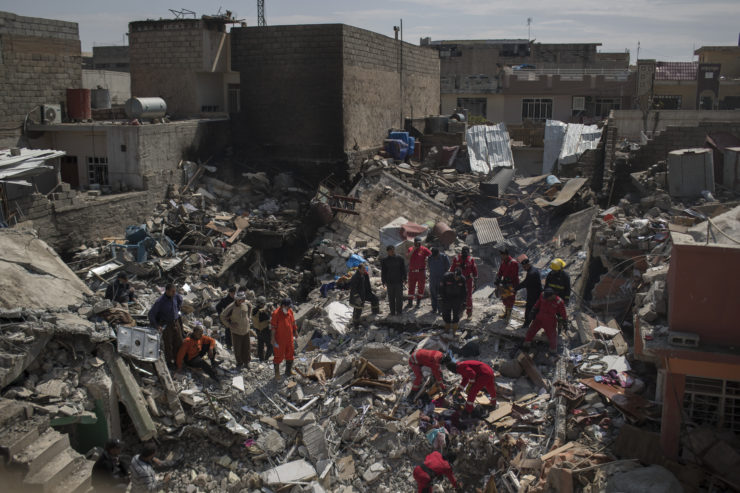
An Iraqi girl was badly burned in a U.S. airstrike in Mosul in March 2017.
“The Uncounted,” Azmat Khan and Anand Gopal’s exhaustively reported investigation into the scale of civilian casualties in the U.S.-led coalition’s fight against ISIS, begins, like many disaster narratives, with a banal domestic scene.
But in this case, the humdrum opening doesn’t just set up the shock of what follows, but also establishes the bizarre circumstances surrounding it: a slice of Westernized middle-class life in the middle of an ISIS occupation.
Late on the evening of Sept. 20, 2015, Basim Razzo sat in the study of his home on the eastern side of Mosul, his face lit up by a computer screen. His wife, Mayada, was already upstairs in bed, but Basim could lose hours clicking through car reviews on YouTube: the BMW Alpina B7, the Audi Q7. Almost every night went like this. Basim had long harbored a taste for fast rides, but around ISIS-occupied Mosul, the auto showrooms sat dark, and the family car in his garage — a 1991 BMW — had barely been used in a year. There simply was nowhere to go.
To draw American readers into this New York Times Magazine story about what many may regard as regrettable but unavoidable collateral damage in the fight against a brutal extremist group, the narrative needed to immediately humanize its protagonist.
For an American audience, “humanize” means to Westernize. So we see Basim and his wife, Mayada, trying to hang onto a semblance of normal life by holding poolside barbecues and eating Chinese takeout, because under ISIS rule they’re afraid to venture out to restaurants they used to frequent. We learn that Basim’s 18-year-old nephew was arrested by ISIS religious police for wearing a shirt with English writing on it and given 10 lashes — punished, basically, for being Westernized. We flash back to the couple’s time living in Michigan, where Mayada was an Avon saleslady (could anything be more solidly middle American?) and they lived in a world of “faculty picnics and Rotary clubs” until they returned to Iraq to be near Basim’s aging parents in 1988.
We also learn of Basim’s “glass-half-full exuberance” stemming from his belief that everything happens for a reason – a naïve optimism, we might think, realizing that something awful is about to befall his family.

The aftermath of a U.S. airstrike in Mosul in March 2017.
And it does: a U.S. coalition airstrike kills his wife, 21-year-old daughter, brother and nephew (the one punished by ISIS for his Western tendencies). The scene, as described from the perspective of a man jolted out of sleep, has the disconnected feeling of a nightmare.
His shirt was drenched, and there was a strange taste — blood? — on his tongue. The air was thick and acrid. He looked up. He was in the bedroom, but the roof was nearly gone. He could see the night sky, the stars over Mosul. Basim reached out and found his legs pressed just inches from his face by what remained of his bed. He began to panic. He turned to his left, and there was a heap of rubble. “Mayada!” he screamed. “Mayada!”
The story of Basim’s search for justice is meticulously detailed, but it’s merely the anchor for a much broader investigation conducted by Khan and Gopal over the course of 18 months using both witness accounts and official analyses. They visited nearly 150 airstrike sites, interviewed hundreds of witnesses to determine the locations of both ISIS facilities and airstrikes – not always the same, as it turns out – analyzed satellite imagery, and cross-tabulated their findings with military records.
In at least one case, the reporters even found the informant who called in a strike that killed seven people in two houses, including an infant. The informant, a local Iraqi official, said he had seen an ISIS mortar under a clump of trees nearby and called in the location.
By the time the information made its way to the coalition and it decided to act, the mortar had been moved.
Such intelligence failures suggest that not all civilian casualties are unavoidable tragedies; some deaths could be prevented if the coalition recognizes its past failures and changes its operating assumptions accordingly. But in the course of our investigation, we found that it seldom did either.
The reporters’ damning finding: that one in five airstrikes examined led to a civilian death, more than 31 times the rate officially acknowledged by the coalition. In some cases, the civilians killed were near actual ISIS targets, but “many others appear to be the result simply of flawed or outdated intelligence that conflated civilians with combatants,” the reporters found. “In this system, Iraqis are considered guilty until proved innocent. Those who survive the strikes, people like Basim Razzo, remain marked as possible ISIS sympathizers, with no discernible path to clear their names.”
The story of Basim’s search for justice is meticulously detailed, but it’s merely the anchor for a much broader investigation.
It may or may not be much comfort, but Basim has now gotten a public clearing of his name via The New York Times – his family was eventually added to the coalition’s official tally of civilian deaths. And documents that the reporters obtained under a Freedom of Information Act yielded some an explanation of why his house was targeted. A report from an investigation into the strike noted that there was no evidence that Basim or his family were ISIS members or supporters and said that their homes may have been confused with a former military facility nearby, which had briefly been occupied by ISIS but then abandoned.
Based on that outdated intelligence, the coalition sent a drone to surveil the houses in short stints over three days.
The investigation acknowledged that “no overtly nefarious activity was observed,” but nonetheless everything the coalition witnessed confirmed its conviction that it was filming a terrorist headquarters. No weapons were visible, but the report noted that ISIS “does not obviously brandish weapons,” so as to go undetected. Occasionally Basim or Mohannad would open their shared gate to the street, allowing a guest to enter. The coalition simply saw men opening a gate, an action that it determined was consistent with the activity of an ISIS headquarters. And, perhaps most important, the report stated that the coalition did not observe any women or children outdoors — although in the ISIS-controlled city, women rarely left the house to avoid the religious police, and most filming had occurred under the blistering afternoon sun, when almost everyone stayed indoors.
Though the Razzos hadn’t known it, the burden of proof had been on them to demonstrate to a drone watching them from above that they were civilians — guilty until proved innocent.
This line, which comes near the end of the lengthy narrative, poignantly encapsulates the piece’s reason for existence – and the sense of injustice that drove Khan and Gopal to spend a year and a half reporting it. They have painstakingly built a case for the innocence of Basim and his family and the carelessness of the system that found them – and many others like them – guilty without a trial.
The piece ends with a pilgrimage to the rubble of Basim’s home, where he finds a platform shoe that had belonged to his daughter sticking out of the debris.
“I told her they were too high and that she would fall,” he said. He could picture her wearing them, coming down the stairs.
The ending is heartbreaking and humanizing at the same time. But we don’t get closure. Neither does Basim. As we learn, the U.S. military eventually made him the rare offer of a condolence payment – in this case, $15,000 – for the loss of his home and family. He turned it down, calling the amount “an insult.” Even if he had received the hundreds of thousands of dollars it would take to replace the destroyed houses, cars and other property, it wouldn’t bring his wife or daughter back.
And for all the effort and potential danger the journalists went through to put together this impressive investigation, it’s not clear that in the next U.S. air campaign anything will change.


